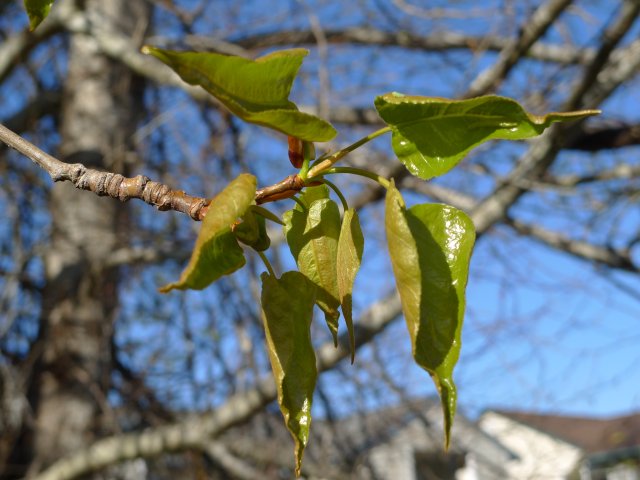Black Cottonwood (Populus trichocarpa)
Published at 10:55 on 21 April 2021

Cottonwood leaves are unfolding and scenting the air with the fragrance of their balsam. The ground under our cottonwood trees is also littered with bud scales sticky with that same fragrant balsam. Indigenous peoples used the balsam to prepare salves and ointments; this tree is part of a small group of related poplar species that produce such balsam.
The Black Cottonwood has something in common with the the Bigleaf Maple, Red Alder, Douglas-Fir, Western Hemlock, Western Red Cedar, and Pacific Madrone. Can you guess what it is?
If you guessed that it is the largest species of its genus, you were correct. Our climate is favorable to the development of large trees, and has selected for them across multiple families and genera.
Like most poplars, this tree has something of a bad reputation for invasive roots that break up pavement and invade pipes. Such traits will likely serve the this region well when our civilization suffers the inevitable demise it is hurtling itself towards; paved surfaces are not very useful to organisms other than civilized humans, and many species will benefit by their return to more productive use.
Many people are surprised to learn that the Black Cottonwood is not our only native poplar. The Quaking Aspen (Populus tremuloides) is also native to the Bellingham area; the Cordata neighborhood in particular has quite a lot of them. Far from being only a Rocky Mountain tree, aspens are in fact the most widely-distributed tree in North America, found from Mexico to Alaska and the Atlantic to the Pacific.
Compared to the Black Cottonwood, the Quaking Aspen has smaller leaves which emerge later in spring, are a lighter green, and much more prone to fluttering in the slightest breeze. Aspens also have lighter bark and more frequently reproduce asexually by sending up suckers from their roots; the latter trait means they typically occur in groves. As with the balsam poplars, the aspens form yet another small, related group of poplar trees; our aspen is a close relative of the aspens of Europe and Asia.
Now that I have mentioned poplars, someone is sure to chime in about how much their seeds trigger their allergies. Actually, it is unlikely that cottonwood seeds would do such a thing; their “fluff” consists of almost pure cellulose, which is not typically considered to be an allergen. Instead, blame grass pollen, whose concentration typically peaks at the same time that cottonwoods are dispersing their seeds.
